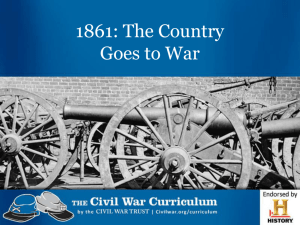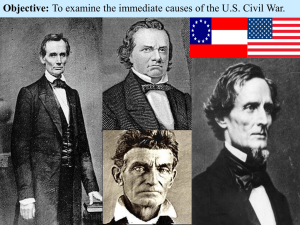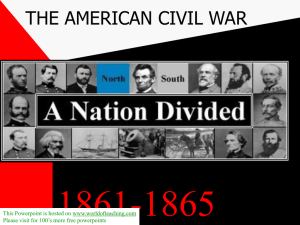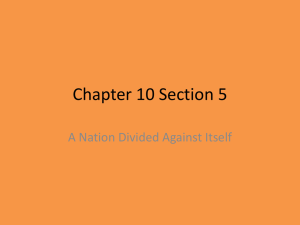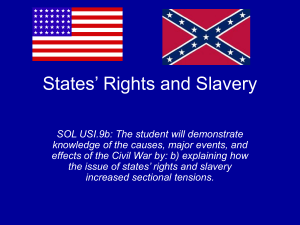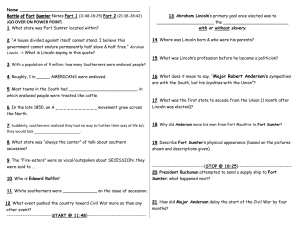CHAPTER 11 THE CIVIL WAR CH. 11
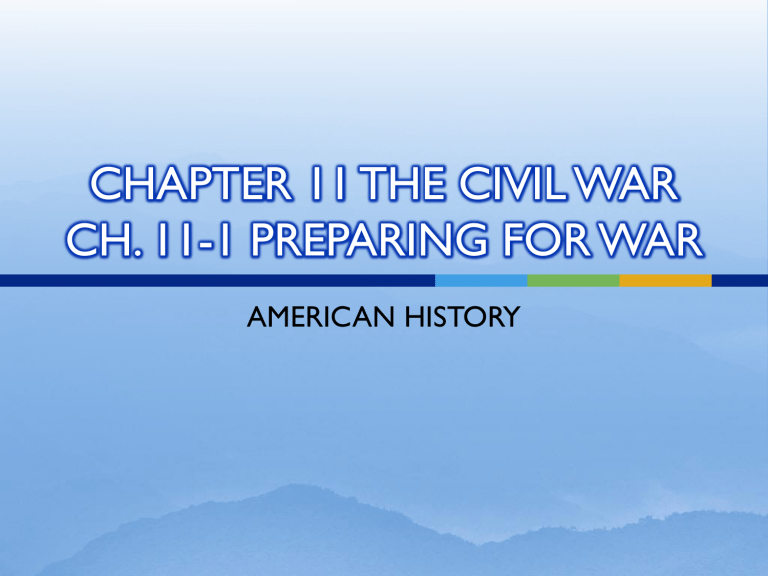
CHAPTER 11 THE CIVIL WAR
CH. 11-1 PREPARING FOR WAR
AMERICAN HISTORY
THE FALL OF FORT SUMTER
April 12, 1861—Confederate forces fire on
Fort Sumter
CRISIS AT FORT SUMTER
March 5, 1861-Cmdr. Robert Anderson sends desperate note to President Lincoln
Confederate leaders demand Anderson surrender Fort Sumter or be fired upon
Lincoln decided to tell Confederates he was going to send only food and nonmilitary supplies to the fort
THE ATTACK ON FORT SUMTER
Jefferson Davis decided to demand surrender or use whatever force necessary to destroy it
April 12, 1861—Confederate artillery opened fire on the fort
Fort Sumter’s defenses were no match and the fort surrendered April 13 th
The southern flag replaced the stars and stripes on
April 14th
THE RUSH TO WAR
President Lincoln calls for 75,000 volunteers to serve for 90 days to put down the rebellion
Northerners rush to enlist in the military
8 remaining southern states had to decide which side to support
MO, AR, KY, NC, TN, VA, DE, MD refused to send troops or ignored the President’s request
April 17—VA secedes
May—AR, TN, NC secede
What would DE, KY, MD, and MO do?
THE BORDER STATES
DE, KY, MD, MO referred to as BORDER
STATES (slave states that remained in the union)
MARTIAL LAW IN MARYLAND
MD most critical border state
Churches required to fly Stars and Stripes
Newspaper supporting secession were closed and owners jailed
Lincoln placed parts of MD under MARTIAL
LAW (military commanders are in control; citizens’ rights and freedoms suspended)
In November 1861 new elections produced a pro-union legislature
DIVISIONS IN MISSOURI
MO controlled the lower Mississippi River
MO stayed in the union
DIVIDED LOYALTIES IN KENTUCKY
Control of KY meant control of 700 miles of the Ohio River
“I hope to have God on my side, but I must have Kentucky”—Abraham Lincoln
Most local officials opposed secession
KY initially said it would remain neutral
KY sided with the union in Sept. 1861 after
Confederate troops invaded.
GOALS AND STRATEGIES
Lincoln couldn’t make the war entirely about slavery
Lincoln said people should fight to preserve the union
South had a simple goal: be left alone with slavery unchanged.
Southerners felt that if they could hold off the
North long enough, the north would grow tired of the war and withdraw
THE NORTH’S STRATEGY
Northern armies needed to invade the south to return states to the Union
North was better prepared for war
More people, factories to fight and produce guns and ammunition
General Winfield Scott did the planning
1) Union navy would blockade southern ports
2) Union gunboats travel down the Mississippi splitting the south in two
Scott’s plan had major flaws
Based on belief that most southerners opposed secession
It would take a lot of time to create an effective blockade
Most northerners wanted a short war
ANACONDA PLAN—name for Scott’s plan given by journalists—based on the snake that slowly squeezed its victim to death
Newspapers suggested that the Union capture the confederate capitol—Richmond, VA to quickly end the war
THE SOUTH’S STRATEGY
South had fewer resources but more support for their cause
White southerners believed that they were fighting for freedom and homeland
Southerners placed great value on bravery and fighting ability
Most of the USA’s most talented military officers were southerners
Most sided with their home state and fought in the confederacy
COTTON DIPLOMACY
The South’s greatest strength over the North was cotton
Huge exports to Great Britain and France
South believed that Great Britain and France would aid the south if the exports were interrupted
COTTON DIPLOMACY—use of cotton as a foreign policy tool
Britain and France did not recognize the
Confederacy as an independent nation
South stopped shipping cotton (EMBARGO)
Britain didn’t appreciate being blackmailed by the South over cotton
THE END


